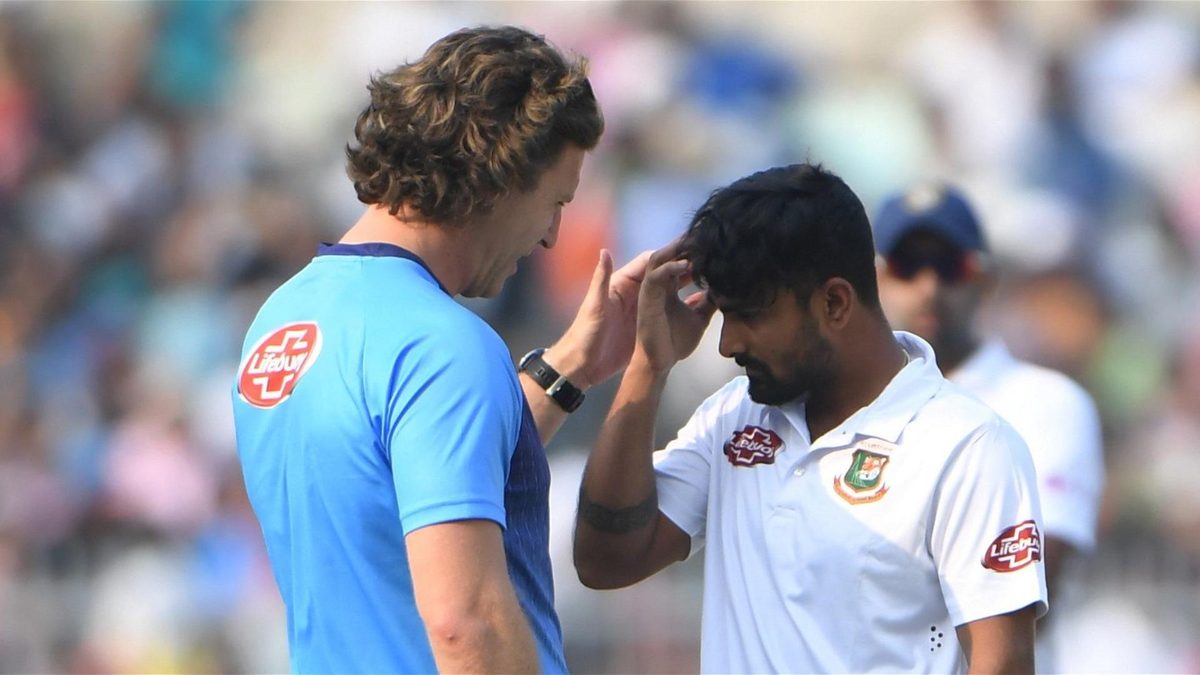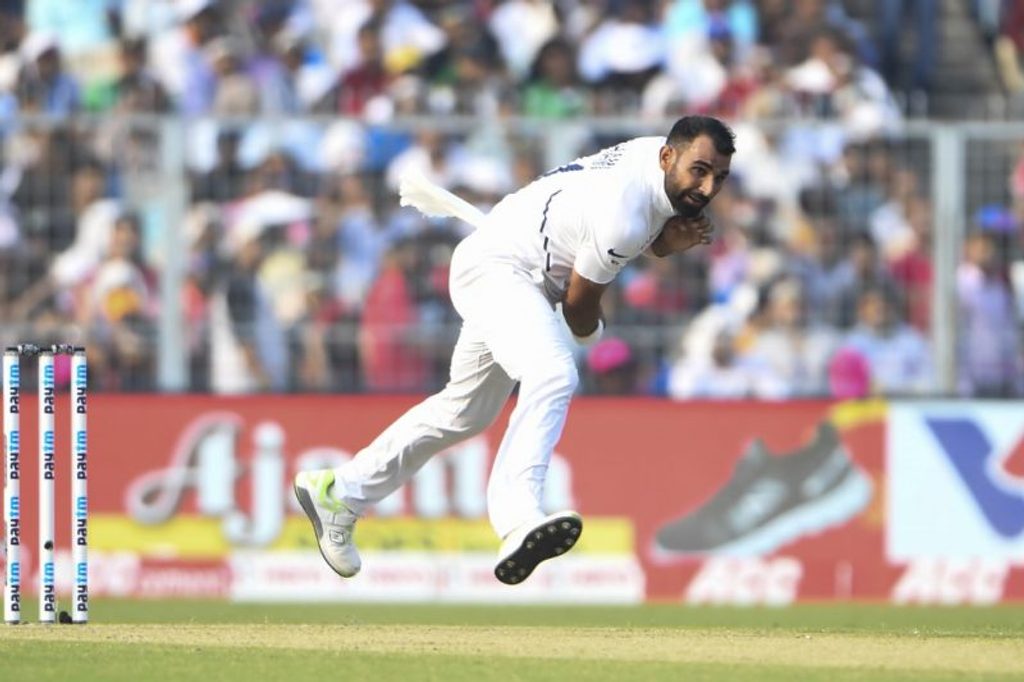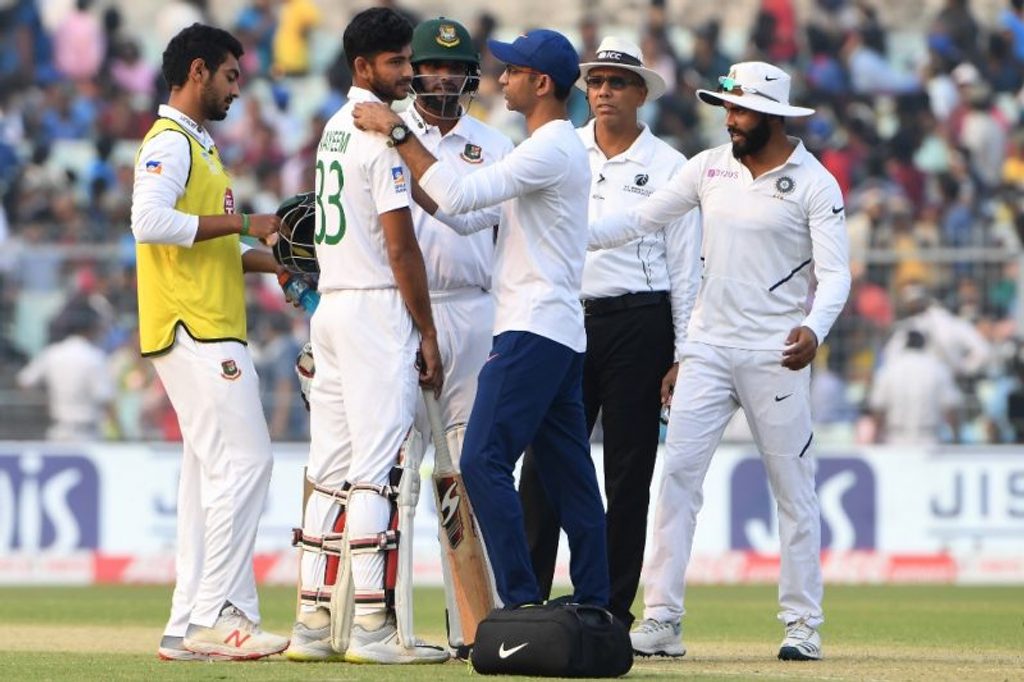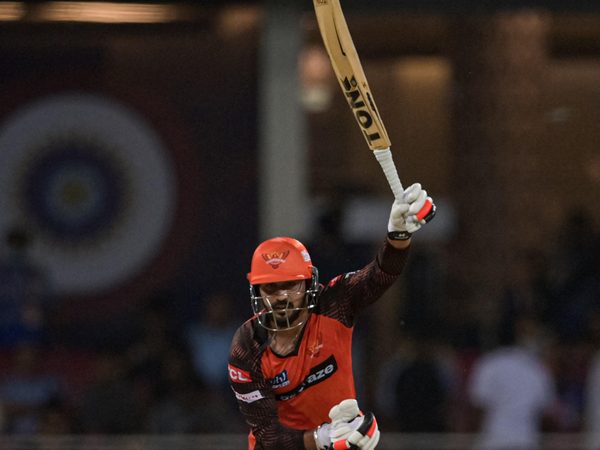
Two concussion subs were used in the same day’s play for the first time in the sport. It’s good to see the new policy in use, but there is plenty more that needs doing to ensure player safety, including change in some attitudes, writes Manoj Narayan.
The pink-ball Test between India and Bangladesh at Eden Gardens was one of several firsts – including the use of not one, but two concussion substitutes in a day.
On Friday, November 22, the first day of the Test, Mohammed Shami was in the thick of the action, part of India’s formidable pace attack in sending down a blistering spell of short-pitched fast bowling that most lower-order batsmen are just not programmed to face. With Bangladesh reduced to 60-6, Liton Das and Nayeem Hasan braved a scary spell from India’s gun bowler either side of the dinner break.
In the 21st over, Shami first rammed one into Liton’s helmet. The batsman attempted a pull, but was too late, and the ball crashed into his helmet at the forehead. The physio rushed on, as per ICC’s concussion protocols, but after some on-the-spot Tests, Liton seemed to suggest to the physio that he was alright to play on – as most players tend to do – and so he did.
[caption id=”attachment_128043″ align=”alignnone” width=”800″] Mohammed Shami was unplayable at times on the first day of the pink ball Test[/caption]
Mohammed Shami was unplayable at times on the first day of the pink ball Test[/caption]
Liton timed the next delivery perfectly, sending it to the fence square. He faced another five balls, finding the fence again, but then suddenly pulled up. Something was amiss, he wasn’t feeling alright, and after a quick chat with the umpire, and the physio who had rushed back in, it was decided he would retire hurt.
Shami continued. With his first delivery of the 23rd over, he struck the helmet again, Nayeem the victim this time against a delivery that whizzed in. The impact seemed just above the left ear region. Nayeem was looked at by the physios (of both teams), and he was deemed fit enough to continue.
Shami didn’t let up on the barrage. Nayeem kept looking away from the ball, and his minimal footwork and habit of taking his eyes off the ball meant he was in no position to play these deliveries efficiently. After a surviving a genuinely scary period, Nayeem fell to Ishant Sharma, and was back in the dressing room. However, an ESPNcricinfo report suggested Nayeem was then taken to the hospital, along with Das, and that Bangladesh had to replace both players with substitutes.
That whole spell made clear a few things. The ICC’s concussion protocols, as they came into effect in August this year, need plenty of work.
In the end, it’s all about the #SpiritOfCricket.#TeamIndia physio, Mr. Nitin Patel attends to Nayeem after he gets hit on the helmet.#PinkBallTest pic.twitter.com/pFXsUfXAUY
— BCCI (@BCCI) November 22, 2019
The rules, as they stand, require that the team physio check a player the minute there’s any impact on the head region. This is to ensure that the impacted player doesn’t feel as if he has to take the brave option and play on. But that is what happened with Liton, who was keen to play on – and that is not unusual. Liton faced six further deliveries after impact, and then started to feel the effects. He retired hurt the second time, but should it have ever come to that?
“You get up and try to act cool,” Australia’s Marnus Labuschagne, who when he came on for Steve Smith in the second Ashes Test this year became the first concussion substitute, had said in London about getting hit on the head. Labuschagne had received a knock in the very second delivery he faced, off the express pace bowling of Jofra Archer. “You just want to stay calm and answer the questions [from the medical staff] properly. I was like, ‘I know where I am, I’m good. Get off the field!’ There’s a process now, but there was no way I was going to get off that field.”
Having been hit a few times over the next couple of Tests, he later added in a press conference, “It’s a bit of a laugh now. [The physio] comes on and I say ‘doc, I’m fine’. He knows now. If I do get hit properly there will be a clear difference. The last two have been glancing blows. I’m getting pretty good at answering the questions. I remember the questions from two days ago.”
So, will the player, or even the team physio, really be the ones to dispassionately identify this ‘clear difference’? Cricket needs neutral physios who can take these calls, to ensure there is absolutely no potential for pressure from the teams to give the go-ahead to a key player. And, players shouldn’t have a say.
[caption id=”attachment_128042″ align=”alignnone” width=”800″] Nayeem Hasan was one of two concussion subs used on the day[/caption]
Nayeem Hasan was one of two concussion subs used on the day[/caption]
Given the potential for delayed onset – Cricket Australia statistics put this number at 30 per cent – the player might well pass the initial tests, and feel its effects later. Perhaps it is also worth considering a mandatory sit-out period of a few overs for players hit on the head. This, admittedly, has its limitations – what happens if it’s the last man who needs to sit out for a bit? Would play be suspended?
But, these are changes worth pursuing, making safety of the players the first priority. And perhaps not just for batsmen: head injury is a concern for bowlers and umpires in the line of fire from a batsman’s shot, and for spectators in this age of manic six-hitting.
Concussion substitutes in Test cricket
Marnus Labuschagne for Steve Smith, Lord’s
Jermaine Blackwood for Darren Bravo, Kingston
Theunis de Bruyn for Dean Elgar, Ranchi
Mehidy Hasan for Liton Das, Kolkata
Taijul Islam for Nayeem Hasan, Kolkata#INDvBAN #PinkBallTest— Deepu Narayanan (@deeputalks) November 22, 2019
Also needing improvement are attitudes surrounding potential concussion. On air during the pink ball Test, Indian commentators, including former players Sunil Gavaskar and Murali Kartik, were cynical, to say the least, in suggesting the players could misuse the substitutions to gain an advantage.
First for all, how that is the case in this instance is unclear; Mehidy Hassan, primarily a bowler, cannot bowl in the match since he replaced a wicketkeeper-batsman in Liton. Saif Hassan would have been the ideal like-for-like replacement for Liton, but he split his webbing two days before the match, and Bangladesh didn’t fly in a replacement.
More pertinently, the players weren’t misusing anything – they carried on playing after being hit – and for all their wealth of experience, the commentators really must understand this is one area where cynicism, or nostalgia, has no place. Safety first, always.








